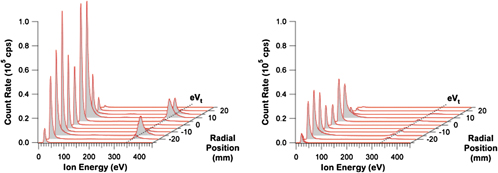Crossref Citations
This article has been cited by the following publications. This list is generated based on data provided by
Crossref.
Bikowski, André
and
Ellmer, Klaus
2012.
Influence of the deposition temperature on electronic transport and structural properties of radio frequency magnetron-sputtered Zn1-xMgxO:Al and ZnO:Al films.
Journal of Materials Research,
Vol. 27,
Issue. 17,
p.
2249.
Bayer, Thorsten J.M.
Wachau, André
Fuchs, Anne
Deuermeier, Jonas
and
Klein, Andreas
2012.
Atomic Layer Deposition of Al2O3 onto Sn-Doped In2O3: Absence of Self-Limited Adsorption during Initial Growth by Oxygen Diffusion from the Substrate and Band Offset Modification by Fermi Level Pinning in Al2O3.
Chemistry of Materials,
Vol. 24,
Issue. 23,
p.
4503.
Bowes, M
Poolcharuansin, P
and
Bradley, J W
2013.
Negative ion energy distributions in reactive HiPIMS.
Journal of Physics D: Applied Physics,
Vol. 46,
Issue. 4,
p.
045204.
Bornholdt, S
Itagaki, N
Kuwahara, K
Wulff, H
Shiratani, M
and
Kersten, H
2013.
Characterization of the energy flux toward the substrate during magnetron sputter deposition of ZnO thin films.
Plasma Sources Science and Technology,
Vol. 22,
Issue. 2,
p.
025019.
Neubert, M.
Cornelius, S.
Fiedler, J.
Gebel, T.
Liepack, H.
Kolitsch, A.
and
Vinnichenko, M.
2013.
Overcoming challenges to the formation of high-quality polycrystalline TiO2:Ta transparent conducting films by magnetron sputtering.
Journal of Applied Physics,
Vol. 114,
Issue. 8,
Bikowski, André
Welzel, Thomas
and
Ellmer, Klaus
2013.
The correlation between the radial distribution of high-energetic ions and the structural as well as electrical properties of magnetron sputtered ZnO:Al films.
Journal of Applied Physics,
Vol. 114,
Issue. 22,
Veith, Gabriel M.
Lupini, Andrew R.
Baggetto, Loïc
Browning, James F.
Keum, Jong K.
Villa, Alberto
Prati, Laura
Papandrew, Alexander B.
Goenaga, Gabriel A.
Mullins, David R.
Bullock, Steven E.
and
Dudney, Nancy J.
2013.
Evidence for the Formation of Nitrogen-Rich Platinum and Palladium Nitride Nanoparticles.
Chemistry of Materials,
Vol. 25,
Issue. 24,
p.
4936.
Scribbins, Steven
Bowes, Michael
and
Bradley, James W
2013.
The spatial distribution of negative oxygen ion densities in a dc reactive magnetron discharge.
Journal of Physics D: Applied Physics,
Vol. 46,
Issue. 4,
p.
045203.
Jia, Junjun
Torigoshi, Yoshifumi
and
Shigesato, Yuzo
2013.
In situ analyses on negative ions in the indium-gallium-zinc oxide sputtering process.
Applied Physics Letters,
Vol. 103,
Issue. 1,
Bikowski, André
Welzel, Thomas
and
Ellmer, Klaus
2013.
The impact of negative oxygen ion bombardment on electronic and structural properties of magnetron sputtered ZnO:Al films.
Applied Physics Letters,
Vol. 102,
Issue. 24,
Partridge, J G
Mayes, E L H
McDougall, N L
Bilek, M M M
and
McCulloch, D G
2013.
Characterization and device applications of ZnO films deposited by high power impulse magnetron sputtering (HiPIMS).
Journal of Physics D: Applied Physics,
Vol. 46,
Issue. 16,
p.
165105.
Welzel, Thomas
and
Ellmer, Klaus
2013.
Comparison of ion energies and fluxes at the substrate during magnetron sputtering of ZnO : Al for dc and rf discharges.
Journal of Physics D: Applied Physics,
Vol. 46,
Issue. 31,
p.
315202.
Welzel, Thomas
and
Ellmer, Klaus
2013.
Negative ions in reactive magnetron sputtering.
Vakuum in Forschung und Praxis,
Vol. 25,
Issue. 2,
p.
52.
Chamorro, W
Horwat, D
Pigeat, P
Miska, P
Migot, S
Soldera, F
Boulet, P
and
Mücklich, F
2013.
Near-room temperature single-domain epitaxy of reactively sputtered ZnO films.
Journal of Physics D: Applied Physics,
Vol. 46,
Issue. 23,
p.
235107.
Weidner, Mirko
Brötz, Joachim
and
Klein, Andreas
2014.
Sputter-deposited polycrystalline tantalum-doped SnO2 layers.
Thin Solid Films,
Vol. 555,
Issue. ,
p.
173.
Bowes, M
and
Bradley, J W
2014.
The behaviour of negative oxygen ions in the afterglow of a reactive HiPIMS discharge.
Journal of Physics D: Applied Physics,
Vol. 47,
Issue. 26,
p.
265202.
Britun, Nikolay
Minea, Tiberiu
Konstantinidis, Stephanos
and
Snyders, Rony
2014.
Plasma diagnostics for understanding the plasma–surface interaction in HiPIMS discharges: a review.
Journal of Physics D: Applied Physics,
Vol. 47,
Issue. 22,
p.
224001.
Welzel, T
Mändl, S
and
Ellmer, K
2014.
Cluster ion formation during sputtering processes: a complementary investigation by ToF-SIMS and plasma ion mass spectrometry.
Journal of Physics D: Applied Physics,
Vol. 47,
Issue. 6,
p.
065204.
Jäger, Timo
Romanyuk, Yaroslav E.
Tiwari, Ayodhya N.
and
Anders, André
2014.
Controlling ion fluxes during reactive sputter-deposition of SnO2:F.
Journal of Applied Physics,
Vol. 116,
Issue. 3,
Alvarez, Rafael
Garcia‐Martin, Jose M.
Lopez‐Santos, Maria C.
Rico, Victor
Ferrer, Francisco J.
Cotrino, Jose
Gonzalez‐Elipe, Agustin R.
and
Palmero, Alberto
2014.
On the Deposition Rates of Magnetron Sputtered Thin Films at Oblique Angles.
Plasma Processes and Polymers,
Vol. 11,
Issue. 6,
p.
571.
